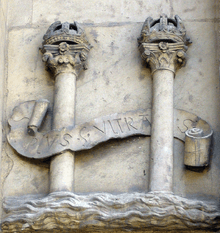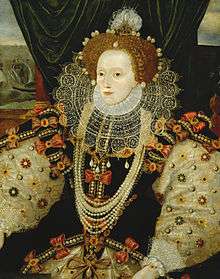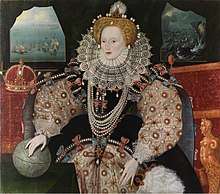Armada Portrait
The Armada Portrait of Elizabeth I of England is the name of any of three surviving versions of an allegorical panel painting depicting the Tudor queen surrounded by symbols of imperial majesty against a backdrop representing the defeat of the Spanish Armada in 1588.
| Armada Portrait | |
|---|---|
.jpg) | |
| Artist | Unknown English artist (formerly attributed to George Gower)[1] |
| Year | 1588 |
| Type | Oil on oak panel |
| Location | Woburn Abbey |
Iconography
The combination of a life-sized portrait of Elizabeth I with a landscape format is "quite unprecedented in her portraiture",[2] although allegorical portraits in this format, such as the Family of Henry VIII: An Allegory of the Tudor Succession (1572) attributed to Lucas de Heere,[3] pre-date the Armada Portrait.
English art in this period was isolated from trends in Catholic Italy, and owed more to Flemish manuscript illumination and heraldic representation than to Renaissance ideas of unity in time and space in art. The 'Armada Portrait' is no exception: the chair to the right is viewed from two different angles, as are the tables on the left, and the background shows two different stages in the defeat of the Armada.[2] In the background view on the left, English fireships threaten the Spanish fleet, and on the right the ships are driven onto a rocky coast amid stormy seas by the "Protestant Wind". On a secondary level, these images show Elizabeth turning her back on storm and darkness while sunlight shines where she gazes, iconography that would be repeated in Marcus Gheeraerts the Younger's 1592 "Ditchley" portrait of the queen.[2]

The queen's hand rests on a globe below a crown (probably not the state crown),[4] "her fingers covering the Americas, indicating England's dominion of the seas and plans for imperialist expansion in the New World".[5][6] The queen is flanked by two columns behind, probably a reference to the famous impresa of the Holy Roman Emperor, Charles V, Philip II's father, which represented the Pillars of Hercules.[7]
Andrew Belsey and Catherine Belsey have pointed out the striking geometry of the painting, with the repeating patterns of circles and arches described by the crown, the globe, and the sleeves, ruff, and gown worn by the queen.[6] They also contrast the imperial figure of the Virgin Queen wearing the large pearl symbolizing chastity suspended from her bodice and the mermaid carved on the chair of state, representing female wiles luring sailors to their doom, another interpretation is that the mermaid symbolizes Mary Queen of Scots. Elizabeth is facing away from Mary indicating that the plots and Mary's execution are all behind her and she doesn't worry about it anymore. The crown also symbolises the English monarch.
Versions
There are three surviving versions of the portrait, in addition to several derivative portraits:
- The version at Woburn Abbey
- The version in the National Portrait Gallery, London, which has been cut down at both sides leaving just a portrait of the queen.
- The version owned by the Tyrwhitt-Drake family, which may have been commissioned by Sir Francis Drake, was first recorded at Shardeloes in Buckinghamshire in 1775. Scholars agree that this version is by a different hand, noting distinctive techniques and approaches to the modelling of the queen's features.[2][5] This version was heavily overpainted in the later 17th century,[2] which complicates attribution and may account for several differences in details of the costume.[8] The Drake version was purchased for the nation for £10.3 million in July 2016 following an Art Fund appeal. The work is hung in the national collection of Royal Museums Greenwich (RMG), in the Queen's House, a 17th-century royal residence built on the site of the original Greenwich Palace, Elizabeth I's birthplace.[9][10]
The first two portraits were formerly attributed to Elizabeth's Serjeant Painter George Gower, but curators at the National Portrait Gallery now believe that all three versions were created in separate workshops, and assign the attributions to "an unknown English artist".[1]
 National Portrait Gallery version
National Portrait Gallery version The "Drake" version, now at Queen's House, Royal Museums Greenwich
The "Drake" version, now at Queen's House, Royal Museums Greenwich
See also
| Wikimedia Commons has media related to Elizabeth I of England (Armada Portrait). |
- Artists of the Tudor Court
- Portraiture of Elizabeth I
- George Gower
- Elizabeth I of England
- 1550–1600 in fashion
Notes
- Cooper, Tarnya; Bolland, Charlotte (2014). The Real Tudors : kings and queens rediscovered. London: National Portrait Gallery. pp. 151–154. ISBN 9781855144927.
- Strong 1987, Gloriana, p. 130–133
- Hearn, Dynasties, p. 81
- Edward Francis Twining (1960). A History of the Crown Jewels of Europe. B. T. Batsford. p. 141.
- Hearn, Dynasties, p. 88
- Andrew Belsey and Catherine Belsey, "Icons of Divinity: Portraits of Elizabeth I" in Gent and Llewellyen, Renaissance Bodies, p. 11–35
- Roy Strong; Art and Power; Renaissance Festivals 1450–1650, p 51, 1984, The Boydell Press;ISBN 0-85115-200-7
- Arnold, Queen Elizabeth's Wardrobe Unlock'd, p. 34–36
- "The Armada Portrait of Elizabeth I". Royal Museums Greenwich. Royal Museums Greenwich. Retrieved 21 October 2018.
References
- Arnold, Janet: Queen Elizabeth's Wardrobe Unlock'd, W S Maney and Son Ltd, Leeds 1988. ISBN 0-901286-20-6
- Cooper, Tarnya; Bolland, Charlotte (2014). The Real Tudors : kings and queens rediscovered. London: National Portrait Gallery. pp. 151–154. ISBN 9781855144927.
- Gent, Lucy, and Nigel Llewellyn, eds: Renaissance Bodies: The Human Figure in English Culture c. 1540–1660Reaktion Books, 1990, ISBN 0-948462-08-6
- Hearn, Karen, ed. Dynasties: Painting in Tudor and Jacobean England 1530–1630. New York: Rizzoli, 1995. ISBN 0-8478-1940-X
- Strong, Roy: Gloriana: The Portraits of Queen Elizabeth I, Thames and Hudson, 1987, ISBN 0-500-25098-7 (Strong 1987)
External links
- Discussion by Janina Ramirez: Art Detective Podcast, 14 December 2016